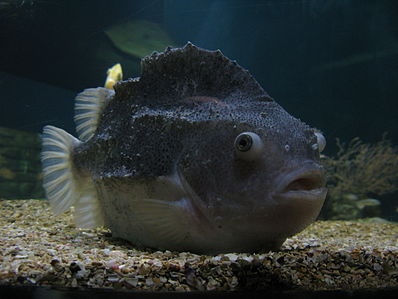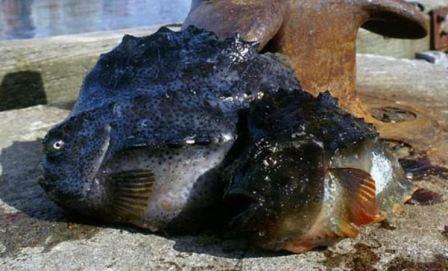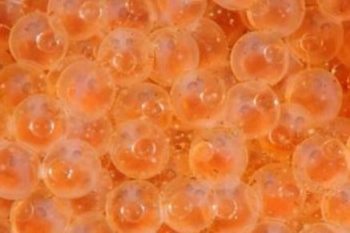Lumpfish fish of the northern seas

Lumpfish (lat. Cyclopterus lumpus) is a species of marine ray-finned fish from the lumpfish family (Cyclopteridae); 17 species of lumpfish are found in Russian waters. Lumpfish is a fish of little commercial importance and is readily caught by amateur fishermen. Lumpfish caviar and meat are used as food; lumpfish fish caught as by-catch are also used to obtain fishmeal.
Content
- Where is lumpfish found?
- What does lumpfish look like?
- What kind of fish is lumpfish?
- Is lumpfish edible or not?
- Lumpfish caviar
- Lumpfish fish for salmon aquaculture
- Fishing for lumpfish in the White and Barents Seas
- Video of the use of lumpfish in salmon aquaculture
Where is lumpfish found?
The lumpfish fish, the sparrow fish, lives in the northern part of the Atlantic Ocean and in the seas of the Arctic Ocean. Different species of lumpfish are found in the Baltic, White, and Barents Seas; recently, the lumpfish has entered the Kara Sea and can be found in the Gulf of Ob. Some lumpfish species are found in the Seas of Okhotsk, Bering and Japan. The lumpfish lives off the coast of Norway, Great Britain, Ireland, Iceland, Greenland, and Canada. Lumpfish is a fish that is found in the sea, like a lumpfish that is found near the coast, but can be found in the open sea. The lumpfish prefers fish of average depth - 50-150 meters, but can also be found at lower depths - up to 300-400 meters. As a rule, the lumpfish is a fish that prefers a rocky bottom, where it likes to hide in a pile of stones. Lumpfish go to shallow waters only during the spawning period, which lasts from the end of May to July.
What does lumpfish look like?

Male lumpfish usually reach a length of 30-40 cm, while female lumpfish are larger and can grow up to 50 cm and weigh 5 kg. The maximum recorded body length is 61 cm, and the weight is 9.5 kg.
The appearance of the lumpfish is somewhat unusual, so it is difficult to confuse it with other fish. It’s not for nothing that another name for lumpfish is sparrow fish.
The lumpfish has a large head and large eyes. The small mouth is lined with strong and sharp conical teeth. Its rounded body on the sides and along the abdomen is strewn with rows of hard growths resembling thorns. Lumpfish is a fish somewhat reminiscent of a huge tadpole. The lumpfish has a suction disc on its throat, with which it can firmly stick to stones. The skin is thick, without scales. Females are blue-green in color, while males are content with the usual outstanding gray or blue-gray color. Diversity in their color occurs only during the breeding season, when the belly acquires a reddish-blue color.
There are two dorsal fins. The first of them becomes covered with skin tissue with age and turns into a high ridge.
What kind of fish is lumpfish?
What kind of fish is lumpfish? The lumpfish feeds on a variety of invertebrates: worms, small jellyfish, crustaceans, and can feed on small jellyfish, and sometimes on the fry of other fish. In turn, the lumpfish is a fish that feeds on halibut, shark and other fish, as well as fish-eating birds. Very often, males guarding a nest with lumpfish eggs die from fish-eating birds.
The spawning period for lumpfish begins at the end of May and lasts until July. At this time, the lumpfish moves from the open sea closer to the coastal part, to shallow water. Most often these are schools of 4-5 year old males and females (it is at this time that they reach sexual maturity). The lumpfish spawns among stones and thickets. It is painted in bright colors - from yellow-orange to brown-crimson. The female can lay from 15 to 200 thousand eggs. Therefore, during the spawning period, the coast becomes multi-colored from a large amount of caviar stuck together in lumps.
During spawning, female lumpfish stop feeding. Having spawned, they go back to the open sea to fatten, while the males remain to guard the nest. When the male guards the nest, he uses the movements of his fin to create water movement, preventing the eggs from becoming covered with silt. During this period, they practically do not feed and are severely depleted, which often leads to their death at an early age compared to females. The male never leaves the nest and if the tide is too high the male dies.
Is lumpfish edible or not?
Sparrow fish or lumpfish is a commercial fish. In the White Sea, commercial fishermen have been catching it since 1934 to this day, although in our time the fishery remains only in the area of the river. Koida in the Mezen Bay. Lumpfish are usually caught in June, when lumpfish come to the shores to spawn. The volume of lumpfish production in the White Sea is small. So in 2003, only 5 tons of lumpfish were caught. It is believed that through fishing, lumpfish can increase the volume of coastal fisheries with some effort.
Mainly lumpfish is a fish caught in Greenland, Iceland, Canada, and Scandinavian countries.
Many people have a question: can lumpfish be eaten or not? Lumpfish meat is a delicacy, the meat of the male lumpfish is especially valued, it is dense, tasty and juicy, the meat of female lumpfish is less valued because of its rlimp and watery. Lumpfish meat does not contain bones; it can be salted, dried, dried, fried, boiled or baked in the oven. The lumpfish is mainly eaten in Scandinavian countries - Denmark, Sweden, as well as in Germany. In Russia, it is mainly eaten on the shores of the White Sea, where it is most often caught.
Lumpfish caviar

Female lumpfish are caught mainly for the purpose of obtaining caviar. Lumpfish caviar is pink, but it is often tinted red or black and then it looks like salmon or sturgeon caviar. Lumpfish caviar tastes like sturgeon caviar. Lumpfish caviar is rich in proteins and vitamins. Often used in oriental cuisine and in Europe. The weight of lumpfish caviar is 20-25% of the weight of the fish and can reach 600-700 grams from one female.
Lumpfish fish for aquaculture salmon
In Norway and Scotland, attempts have been made since 2015 to use lumpfish to eliminate salmon lice in fisheries. In Scotland, a technology has been developed in which lumpfish are grown for 3-4 years, and then placed in cages with salmon. In each fish tank with salmon, 5-6 thousand lumpfish are placed, a fish that fights sea lice. The production of lumpfish in Scottish aquaculture is already in the millions.
Fishing for lumpfish on the White and Barents Seas
Lumpfish fish has not only commercial significance. Lumpfish are also an object of amateur fishing. Lumpfish fish is well caught in Sea, but as a rule, it is not caught purposefully; most lumpfish fish accidentally end up in the catches of amateur fishermen who catch cod and other fish from the bottom. Lumpfish are usually caught at depths of up to 50 m using a spinning rod with a heavy sinker.
To catch lumpfish, you need bait such as shellfish meat, cut fish, and sandworms. It is also possible to catch lumpfish using a spoon. Spinner baits work well. The fisherman carries out a “step” type wiring. Usually the lumpfish grabs the bait after a pause at the moment it starts moving.
The bite of the lumpfish is strong and decisive; you need to hook it immediately, otherwise the lumpfish is a bottom-dwelling fish and immediately after taking the bait it tends to hide in the rocks, which risks the line getting tangled in the rocks and breaking off. Also, lumpfish is a fish with a large suction cup on its belly; it can “stick” to a stone and it will be extremely difficult to tear it off.